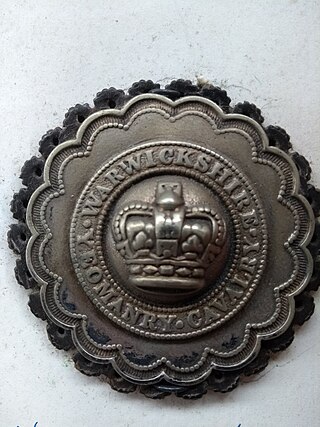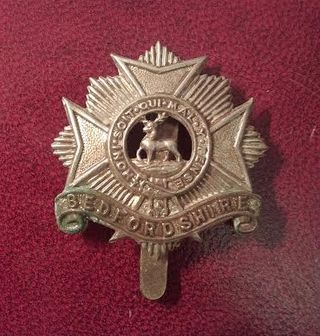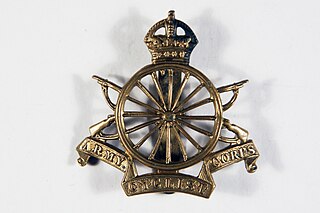
The 54th Infantry Division was an infantry division of the British Army. The division was raised in 1908 following the creation of the Territorial Force (TF) as the East Anglian Division. During the First World War the division fought at Gallipoli and in the Middle East. The division was disbanded after the war but reformed in the Territorial Army in 1920. During the Second World War it was a home service division and did not see any combat service abroad and was disbanded in late 1943 but many of its component units went to see service in the Normandy Campaign and North-western Europe from June 1944 to May 1945.

The Essex Regiment was a line infantry regiment of the British Army in existence from 1881 to 1958. The regiment served in many conflicts such as the Second Boer War and both World War I and World War II, serving with distinction in all three. It was formed in 1881 under the Childers Reforms by the amalgamation of the 44th Regiment of Foot and the 56th Regiment of Foot.

The 143rd Infantry Brigade was an infantry brigade of the British Army that saw active service in both the First and the Second World Wars. In the First World War the brigade served on both Western Front and later the Italian Front. During the Second World War the brigade fought in Belgium and France before being evacuated to England where it remained for the rest of the war and was finally disbanded in 1946. Raised again in the 1980s, this brigade disbanded under Army 2020 in November 2014.

The Home Counties Division was an infantry division of the Territorial Force, part of the British Army, that was raised in 1908. As the name suggests, the division recruited in the Home Counties, particularly Kent, Middlesex, Surrey and Sussex.

The 1st Cavalry Division was a regular Division of the British Army during the First World War where it fought on the Western Front. During the Second World War it was a first line formation, formed from Yeomanry Regiments. It fought in the Middle East before being converted to the 10th Armoured Division.

The 49th Infantry Brigade, later known as 49th (Eastern) Infantry Brigade during the Cold War, was a brigade of the British Army.

The 145th Infantry Brigade was a regional brigade of the British Army that saw active service in both the First and the Second World Wars, disbanding in 1943 and being reformed in the 1990s. The Brigade was renamed Headquarters 11th Infantry Brigade and Headquarters South East in October 2014.

The Warwickshire Yeomanry was a yeomanry regiment of the British Army, first raised in 1794, which served as cavalry and machine gunners in the First World War and as a cavalry and an armoured regiment in the Second World War, before being amalgamated into the Queen's Own Warwickshire and Worcestershire Yeomanry in 1956. The lineage is maintained by B Squadron, part of The Royal Yeomanry.

The Bedfordshire and Hertfordshire Regiment was the final title of a line infantry regiment of the British Army that was originally formed in 1688. After centuries of service in many conflicts and wars, including both the First and Second World Wars, the regiment was amalgamated with the Essex Regiment in 1958 to form the 3rd East Anglian Regiment. However, this was short-lived and again was amalgamated, in 1964, with the 1st East Anglian Regiment and 2nd East Anglian Regiment, and the Royal Leicestershire Regiment to form the present Royal Anglian Regiment.

The Army Cyclist Corps was a corps of the British Army active during the First World War, and controlling the Army's bicycle infantry.
During the First World War the British Armed Forces was enlarged to many times its peacetime strength. This was done mainly by adding new battalions to existing regiments. Although sometimes identified by shoulder titles, generally the new battalions could not be identified from appearance. Consequently, the units in this list have been assembled considering only those as having a uniquely different cap badge.
The 157th Brigade was an infantry brigade of the British Army. The brigade fought in both the First and the Second World Wars, assigned to 52nd (Lowland) Infantry Division.

The East Midland Brigade was an infantry brigade of the Territorial Force, part of the British Army, that was raised in 1908. As the name suggests, it commanded infantry battalions recruited in the East Midlands of England: Bedfordshire, Northamptonshire, Cambridgeshire and Hertfordshire. The brigade was an integral part of the East Anglian Division.
The 166th Brigade was an infantry brigade of the British Army that saw active service in the First World War and remained in the United Kingdom throughout the Second World War.
220th Brigade was a Home Service formation of the British Army during the First and Second World Wars.
The 222nd Infantry Brigade was a Home Service formation of the British Army that existed under various short-lived titles in both the First and Second World Wars

The 223rd Brigade was a Home Defence formation of the British Army in the First and the Second World Wars. It existed under several variations of the 223 Brigade title, and was eventually converted into an airborne formation.
The 225th Brigade was a Home Defence formation of the British Army in the First and the Second World Wars. It existed under several variations of the 225th Brigade title.
The 1st Northamptonshire Rifle Volunteers were a unit of the British Army raised from 1859 onwards as a group of originally separate Rifle Volunteer Corps (RVCs). They later became the 4th Volunteer Battalion of the Northamptonshire Regiment and saw action in the Gallipoli and Palestine campaigns during the First World War. Converted into a searchlight unit between the wars, they served in the defence of the United Kingdom and as an infantry regiment in liberated Norway during the Second World War. Postwar they continued in the air defence role until 1961 when they reverted to infantry as part of the Royal Anglian Regiment.
The IV East Anglian Brigade of the Royal Field Artillery was a unit of Britain's Territorial Force (TF) from 1908 to 1919. It served in the Sinai and Palestine Campaign during World War I.














